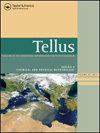高山冰芯大气硫酸盐的人为与自然来源
IF 4.3
4区 地球科学
Q3 METEOROLOGY & ATMOSPHERIC SCIENCES
Tellus Series B-Chemical and Physical Meteorology
Pub Date : 1999-11-01
DOI:10.3402/TELLUSB.V51I5.16506
引用次数: 77
摘要
与温室气体相反,硫酸盐气溶胶粒子预计会导致气候变冷,但其源变率和强度存在不确定性。我们分析了来自欧洲冰川的冰芯,量化了200年来气溶胶携带的硫酸盐的来源强度。二氧化硫排放产生的硫酸盐在本世纪增加了一个数量级以上。在工业时期,这一人为来源约占总硫酸盐的80%,反映了西欧国家的排放。在工业化前时期,矿物粉尘是主要的贡献者,其次是火山或生物质燃烧产生的二氧化硫排放的硫酸盐。DOI: 10.1034 / j.1600 0889.1999.t01 - 4 - 00006. x本文章由计算机程序翻译,如有差异,请以英文原文为准。
Anthropogenic versus natural sources of atmospheric sulphate from an Alpine ice core
Opposite to greenhouse gases, sulphate aerosol particles are expected to cause climate cooling, but uncertainties exist about source variability and strength. We analysed an ice core from a European glacier to quantify source strengths of aerosol-borne sulphate over a 200-year period. Sulphate from emissions of SO 2 increased by more than an order of magnitude during this century. This anthropogenic source is responsible for about 80% of total sulphate in the industrial period, and reflects emissions of west European countries. In the pre-industrial period mineral dust was the dominant contributor, followed by sulphate from SO 2 emissions with volcanoes or biomass burning as possible sources. DOI: 10.1034/j.1600-0889.1999.t01-4-00006.x
求助全文
通过发布文献求助,成功后即可免费获取论文全文。
去求助
来源期刊
自引率
0.00%
发文量
3
期刊介绍:
Tellus B: Chemical and Physical Meteorology along with its sister journal Tellus A: Dynamic Meteorology and Oceanography, are the international, peer-reviewed journals of the International Meteorological Institute in Stockholm, an independent non-for-profit body integrated into the Department of Meteorology at the Faculty of Sciences of Stockholm University, Sweden. Aiming to promote the exchange of knowledge about meteorology from across a range of scientific sub-disciplines, the two journals serve an international community of researchers, policy makers, managers, media and the general public.

 求助内容:
求助内容: 应助结果提醒方式:
应助结果提醒方式:


